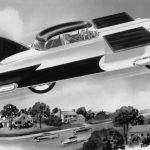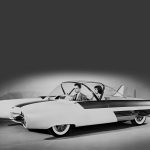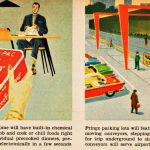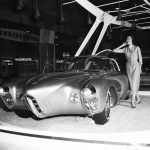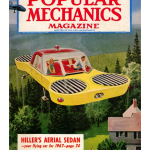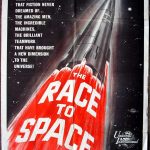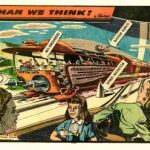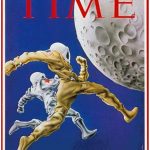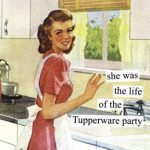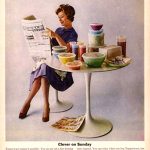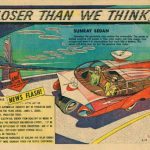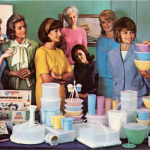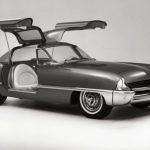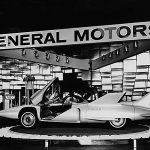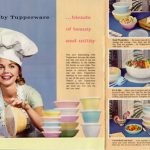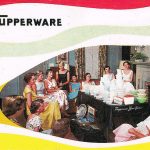Looking Ahead
In the 1950s, images of the future were tightly interwoven with the social, political, and economic phenomena that defined the decade. From the space race that would grow out of the increasingly hostile Cold War to Americans’ continuing obsession with automobiles, the future offered a source of wonderment and fascination — as well as a means of promoting the most up-to-date consumer products.
Automobiles
In 1956, the federal government passed
the Interstate Highway Act to fund construction of interstate highways across the country. At the same time, young suburban families, with more spending money than ever, were buying more cars. During the 1950s, the automobile industry saw growth and change, particularly in its design departments. Car companies catered to young buyers’ tastes as well as their fantasies. Cars were designed to resemble airplanes and rockets, with sleek, lightweight bodies, wraparound windshields, and jet-inspired grilles.
://https://www.youtube.com/watch?v=Dz8HbGjsxM4/watch?v=Dz8HbGjsxM4
Kitchens of the Future
Car companies exhibited the newest and most exciting household appliances in order to interest wives accompanying their husbands to auto shows. These “Kitchens of the Future” promised unimaginable efficiency at the push of a button for the American housewife, as well as modern, stainless-steel elegance. Americans bought it: in the first five years after World War II, the amount of money spent on household furnishings and appliances rose by an incredible 240 percent, more than in any other spending category. Advertising campaigns in print and on TV promised release from the back-breaking drudgery of housework by comparing “before” kitchens to modern, clean, and sleekly-decorated “after” kitchens. Manufacturers appealed to lower middle-class women by displaying their appliances as upper-class commodities, showing a woman in an evening gown preparing a cake by pushing a button, with time to spare to squeeze in a game of tennis or a round of golf. Cutting-edge appliances promised a future where any woman would have the kind of leisure time usually afforded only to the upper class.
The Space Race
As the Cold War took hold, the United States and the Soviet Union debated the merits of their ways of life — and raced to launch the first space probes. Americans were convinced of the superiority of American capitalism, pointing to the proliferation of consumer goods that improved their lives. As the United States saw its western frontiers become more and more populated, its fascination with a new frontier — space — grew. Radio and television featured programs like Space Patrol, which ran from 1950 to 1955. The show followed the adventures of Commander Buzz Corey as he fought to keep the galaxy safe. Space Patrol was a classic American western, set in a futuristic locale. In the world of Buzz Corey, space was most definitely an all-American place. Americans held onto their fictional images of space even though the country found itself trailing behind in the Space Race. On October 4, 1957, Americans learned with disappointment that the Soviet Union had successfully launched Sputnik, the first satellite to orbit the earth.
The Wonderbowl
Images of the future were as prevalent in the world of plasticsas they were elsewhere in 1950s America. Tupperware Home Parties used an outer space theme in some of their promotions and Jubilees, and even scheduled the 1960 Spacecapades Jubilee around the visible orbit of Sputnik. The company considered its own classic Wonderbowl, with its sleek, minimalist style, to be on the cutting edge of dishware, and Tupperware was prominently featured in Disney’s House of the Future. Like many Americans in the 1950s, Tupperware’s rank and file found excitement, refuge, and hope in conceptions of a better future.
( the future of the world is dreamed by dreamers but these ideas and aspirations will always shape the next generation…)



